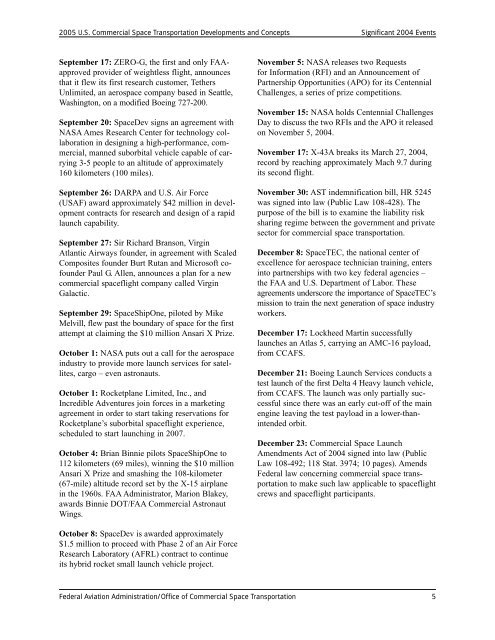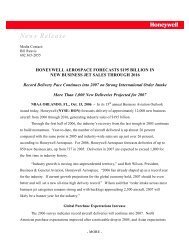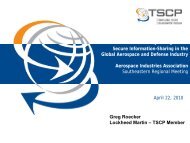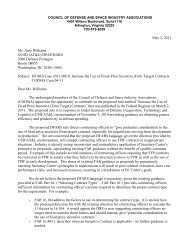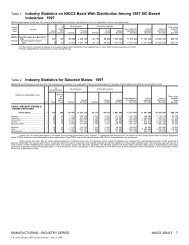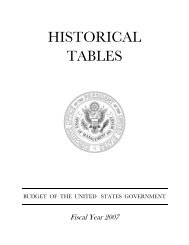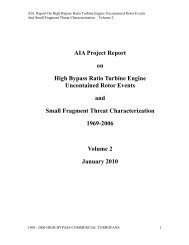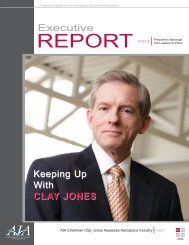Untitled - Aerospace Industries Association
Untitled - Aerospace Industries Association
Untitled - Aerospace Industries Association
Create successful ePaper yourself
Turn your PDF publications into a flip-book with our unique Google optimized e-Paper software.
2005 U.S. Commercial Space Transportation Developments and Concepts Significant 2004 EventsSeptember 17: ZERO-G, the first and only FAAapprovedprovider of weightless flight, announcesthat it flew its first research customer, TethersUnlimited, an aerospace company based in Seattle,Washington, on a modified Boeing 727-200.September 20: SpaceDev signs an agreement withNASA Ames Research Center for technology collaborationin designing a high-performance, commercial,manned suborbital vehicle capable of carrying3-5 people to an altitude of approximately160 kilometers (100 miles).September 26: DARPA and U.S. Air Force(USAF) award approximately $42 million in developmentcontracts for research and design of a rapidlaunch capability.September 27: Sir Richard Branson, VirginAtlantic Airways founder, in agreement with ScaledComposites founder Burt Rutan and Microsoft cofounderPaul G. Allen, announces a plan for a newcommercial spaceflight company called VirginGalactic.September 29: SpaceShipOne, piloted by MikeMelvill, flew past the boundary of space for the firstattempt at claiming the $10 million Ansari X Prize.October 1: NASA puts out a call for the aerospaceindustry to provide more launch services for satellites,cargo – even astronauts.October 1: Rocketplane Limited, Inc., andIncredible Adventures join forces in a marketingagreement in order to start taking reservations forRocketplane’s suborbital spaceflight experience,scheduled to start launching in 2007.October 4: Brian Binnie pilots SpaceShipOne to112 kilometers (69 miles), winning the $10 millionAnsari X Prize and smashing the 108-kilometer(67-mile) altitude record set by the X-15 airplanein the 1960s. FAA Administrator, Marion Blakey,awards Binnie DOT/FAA Commercial AstronautWings.November 5: NASA releases two Requestsfor Information (RFI) and an Announcement ofPartnership Opportunities (APO) for its CentennialChallenges, a series of prize competitions.November 15: NASA holds Centennial ChallengesDay to discuss the two RFIs and the APO it releasedon November 5, 2004.November 17: X-43A breaks its March 27, 2004,record by reaching approximately Mach 9.7 duringits second flight.November 30: AST indemnification bill, HR 5245was signed into law (Public Law 108-428). Thepurpose of the bill is to examine the liability risksharing regime between the government and privatesector for commercial space transportation.December 8: SpaceTEC, the national center ofexcellence for aerospace technician training, entersinto partnerships with two key federal agencies –the FAA and U.S. Department of Labor. Theseagreements underscore the importance of SpaceTEC’smission to train the next generation of space industryworkers.December 17: Lockheed Martin successfullylaunches an Atlas 5, carrying an AMC-16 payload,from CCAFS.December 21: Boeing Launch Services conducts atest launch of the first Delta 4 Heavy launch vehicle,from CCAFS. The launch was only partially successfulsince there was an early cut-off of the mainengine leaving the test payload in a lower-thanintendedorbit.December 23: Commercial Space LaunchAmendments Act of 2004 signed into law (PublicLaw 108-492; 118 Stat. 3974; 10 pages). AmendsFederal law concerning commercial space transportationto make such law applicable to spaceflightcrews and spaceflight participants.October 8: SpaceDev is awarded approximately$1.5 million to proceed with Phase 2 of an Air ForceResearch Laboratory (AFRL) contract to continueits hybrid rocket small launch vehicle project.Federal Aviation Administration/Office of Commercial Space Transportation 5


